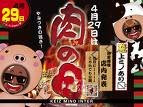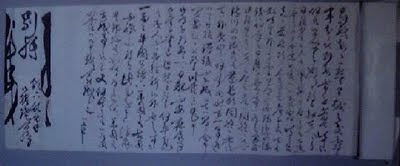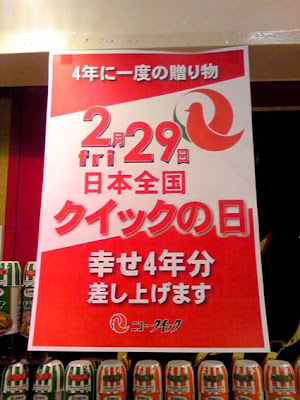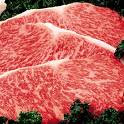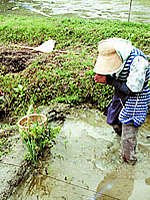! SEARCH THIS BLOG !
:::::::::::::::::::::::::::::::::::::::::::::::::::::::::::::::::::::::::::::::::::::::::::::::::::::
Train Station Lunch Box (ekiben)
***** Location: Japan
***** Season: Kigo for late spring
***** Category: Humanity
*****************************
Explanation
ekiben 駅弁 famous lunch boxes at every train station,
Bahnhofs-Bentō
a box lunch (sold at train stations or on trains), railway boxed meal
railroad boxed meal, railway lunchbox

Ekiben Mark 駅弁マーク
Every officially approved ekiben carries this mark, since 1988.
日本鉄道構内営業中央会
On April 10 is the day of the Ekiben
ekiben no hi 駅弁の日!
The Chinese character 弁 looks like a 十 (ten) and the image of number 4 are combined in the image pun for this day.
Thanks to Mariko Shimizu for this info.
Bento, bentoo 弁当 lunch box, lunchbox, Lunchpaket
bentoobako, bentobako, boxes for this lunch 弁当箱
Bentō; O-Bentō, Lunch-Paket
Bentō-Schachtel; Frühstückskasten, Bentoschachtel

source : keionet. order bento online
Many department stores have special sales of famous EKIBEN. You can order them also online.
The containers too are attractive and many collect them. They can be made from ceramic, wood or plastic. Some can later be used as something else, for example a piggy bank.
Others are not so special on the outside and just have a nice label.
Ekiben should contain some rice to live up to its name.
There are also many sandwiches sold at stations.
There is also a museum, EKIBEN Hakubutsukan
駅弁博物館
external LINK
驛弁博物館
ekiben gurume 駅弁ぐるめ gourmet who travels to eat ekiben
In 2007, there were special ekiben prepared along the Tokaido line for its 120 years of existence.
東海道線120周年記念
::::::::::::::::::::::::::::::::::::::::::::::::::::::::::::::::::::::::::::::::::::::::::::::::::::
History of the Ekiben 駅弁の歴史
The first train lines opened in 1872.
A lot of written material has been lost during the war.
The first Tokaido line between Tokyo and Kobe opened in 1889 and since then the dining cars and lunch box operations became a general busines.
The first lunch boxes were simple nigiri rice balls.
In 1888 the first "maku no uchi bento 幕の内弁当" with more ingredients was sold at Himeji Station. It contained one box with rice and one box with the ingredients.
In 1890 the first lunch boxes with local specialities were sold at Ichinoseki and Kurosawajiri (Iwate). They sold sushi.
In 1899 the first dining car operated.
Some stations take pride in being the really first ones to sell this kind of lunchbox.
Utsunomiya 宇都宮 (Tochigi) in 1885
梅干入りごま塩握り飯
A simple nigiri with black sesame outside and a dried plum inside, and a slice of takuan pickled radish to go with it.
First made by the restaurant Shiragiya 白木屋.
Umeda 梅田(Osaka) in 1877
Kobe (Hyogo) in 1877
Travellers had to buy it before boarding. Mostly for soldiers of the "Seinan War" with Kagoshima and Kyushu. The ships with the soldiers sailed from Kobe to the south, and soldiers moved from Osaka station to Kobe station.
Koyama 小山駅 (Tochigi) in 1885
Okinazushi 翁ずし with nori seaweed, abura-age tofu and an egg.
Made by Kashiwaya 柏屋. An old maid called OKINA made very good sushi by hand and sold it.
Ueno 上野 (Tokyo) in 1883
made by Fujinoya 弁当料理ふぢのや
Kumagaya (Saitama) in 1883
Since the first day of the train line, they sold sushi and bread.
Ueno and Kumagaya lines opened in the same year and some sold the lunch boxes "outside the station" (eki mae).
Takasaki 高崎 (Gunma) in 1884
mentioned in a survey of Ekiben in 1956.
Some trains seemed to have had a dining car, shokudoosha 食堂車.
Takaben later became famous because they used a container with Daruma san.

Takaben - Takasaki Bento Daruma
::::::::::::::::::::::::::::::::::::::::::::::::::::::::::::::::::::::::::::::::::::::::::::::::::
Bentoobako ― Lunchboxes with Daruma Bentoobako 弁当箱
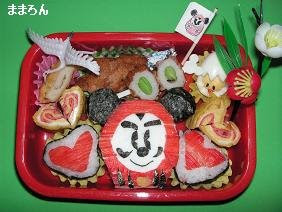
:::::::::::::::::::::::::::::::::::::::::
In 1914 the modernism of the Taisho-Period began and also the first world war started. More lunch boxes were sold at many stations. The wrapping paper for lunch boxes became more elaborate with special local designs.
During world war 2 rice became scarce and many lunch boxes served bread or other grains instead. Since 1945 after the war people got used to eating out and the consumption of lunch boxes soared. Also "army lunch boxes" (gunben 軍弁) became popular.

source . http://www.ekibento.jp/nos-senzen-gunben1.htm
After 1956 the Tokaido Main Line became electrified, in 1969 the Tokaido Shinkansen 東海道新幹線 started to run. Along with the travelling boom came the need for more and more specialized local ekiben.
Since 1960 there is an annual "Ekiben Meeting" ekiben taikai 駅弁大会 with a competition to win.
Even now, when people can buy cheap lunch boxes at convenience stores in front of a station, many still prefer the real EKIBEN.
The most expensive, by the way, is the one with special Matsuzaka beef and costs more than 100 dollars.
極上松阪牛ヒレ牛肉弁当
:::::::::::::::::::::::::::::::::::::::::::::::::::::::::::::::::::::::::::::::::::::::::::::::::::

Ekiben selling(駅弁売り) - The man or woman who sells "Ekiben"
on the platform to the passengers in the train,while the train stops at the station.
This work has gone since the current train window will not open, but The window from the Meiji to the Showa period was easily opened by hand.
Railway advertisement in the Meiji Taisho period
Lithographic Printing, a Beauty riding at the first class train and Ekiben Selling
36.5 cm × 25.5 cm
- source : Hiromi on facebook 2017 -

Georges-Ferdinand Bigot (1860-1927)
"Railroad between Tokyo to Kobe" published in 1893.
on the platform Ekiben selling · · · only for 1st,2nd class cars
- source : Hiromi on facebook 2017 -
:::::::::::::::::::::::::::::::::::::::::::::::::::::::::::::::::::::::::::::::::::::::::::::::::::
Famous Ekiben A B C
Aizu Wakamatsu (Fukushima)
Kurisansai bentoo with chestnuts and mountain vegetables
Goshokawahara (Aomori, Tsugaru)
Dazai bentoo だざい弁当 lunchbox a la Dazai
Hamamatsu (Shizuoka)
unagi meshi eel with rice
Hachinohe (Aomori)
tako ninniku buta kimuchi don 田子にんにく豚キムチ丼
Rice with garlic and pork kimchee

Hitoyoshi (Kumamoto) 人吉駅弁
kuri bentoo 栗弁当 with sweet chestnuts
kuri meshi 栗めし, served in a container shaped like a chestnut
ayuzushi 鮎すし sushi of a whole sweetfish
. . . CLICK here for Photos !
Kamogawa (Chiba) 鴨川
umi to sazae meshi うにとさざえめし rice with uni and sazae
. . . CLICK here for Photos !
oraga don おらが丼」"my very own bowl" rice with seafood
. . . CLICK here for Photos !
Kanayama (Chiba) 金山
biwa bentoo びわ弁当
ichigo mochi
kujira bentoo くじら弁当
Kareigawa (Kumamoto ) 嘉例川駅
百年の旅物語 かれい川 Kareigawa : Hyakunen no Tabi Monogatari
Kisarazu (Chiba) 木更津
asari bentoo アサリ弁当 / 漁り(あさり)
nanohana bentoo 菜の花弁当
. . . CLICK here for Photos !
Kobe (Hyogo)
Shin-Kobe Shinkansen
Toomasu ranchi トーマスランチ
Lunchbox with Thomas, the locomotive
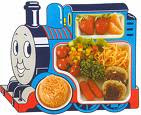
Koriyama Kooriyama 郡山, Fukushima
Aizu Jidori Torimeshi 会津地鶏 Local Chicken Meat from Aizu Wakamatsu
Kuji 奥久慈駅弁 Oku Kuji Ekiben
Shamo Bento しゃも弁当 , Local Chicken Lunchbox
Kuroiso (Tochigi)
Kijiyaki, fried pheasant
. . . CLICK here for Photos !
Matsue ( Shimane )
Oyogi-ushi no bentoo およぎ牛の弁当 with beef from the "swimming cows" of Oki no shima 隠岐の島.
Matsuzaka (Mie)
Mootaroo bentoo モー太郎弁当
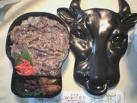
With the famous Matsuzaka beef!
also
極上松阪牛ヒレ牛肉弁当 : The most expensive one in Japan.
. . . CLICK here for Photos of the most expensive beef filet !
COWS in Japan and the World
The Daily MOOOO BLOG / Amy Chavez
Miyajima (Hiroshima)
Anago Meshi 穴子飯弁当 . あなごめし Rice with conger eel
Miyako 宮古 (Iwate)
Ichigo bentoo いちご弁当
Lunchbox with uni and awabi, sea urchin eggs and abalone
Mitsuwasoo (Miyazaki)
Mitsuwasoo 三ツ和荘道弁
sono manma そのまんま 宮崎地鶏丼 jidori don with local chicken

Nagoya (Aichi)
ganso misokatsu monogatari "元祖みそかつ物語”
Original cotelette with miso Story,
with cutlets on a stick
. . . CLICK here for Photos !
. "Nobunaga Bento" 「信長膳」Nobunaga Zen .
Nikko 日光 Tobu Line
masu sushi 日光鱒寿し Sushi from masu, local trout
Numazu Shizuoka
Minato Ajizushi mackerel sushi with extra wasabi
Oarai, O-Arai (Ooarai 大洗駅弁) Kagoshima
Isobushi Bento 磯節弁当 "Seashore Lunchbox"
Odawara (Kanagawa)
tai meshi たいめし
Odate (Akita)
大館駅, Oodate eki
Matagi na torimeshi マタギな鶏めし
Chicken with rice like the bear hunters
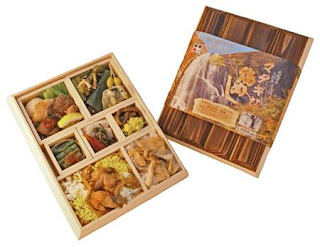
Okayama 岡山
Momotaro bento 桃太郎
. . . . . Matsurizushi 祭り寿司 Sushi with various toppings
. . . . . おかやま和牛肉弁当 Bento with beef from Okayama with 牛時雨(しぐれ)煮
Orio Kashiwameshi 折尾駅 かしわめし Kitakyushu
Osaka
Shin-Osaka Tokaido Shinkansen and Tokaido
Hakkaku Bento 八角弁当 with eight corners
Conger eel roll, koya-dofu (freeze-dried bean curd), kelp roll, eggplant cut into pieces, taro and lotus root cooked in mild-tasting Kansai style. No deep-fried food.
. . . CLICK here for Photos !
Shimizu (Shizuoka)
Sakura ebi sushi 桜えびすし
sushi with sakura shrimp
Shimonoseki (Yamaguchi)
gansoo fukumeshi 元祖ふくめし
the original puffer fish with rice
Shizuoka
tai red snapper
Shuzenji (Shizuoka)
Ajizushi no ekiben あじ寿司 駅弁 Horse makerel sushi
Takamatsu (Kagawa)
Anpanman bentoo アンパンマン弁当
. . . CLICK here for Bentoo Photos !
anpan あんパン bread or bun with an (sweet bean paste)
Tateyama 館山 (Chiba)
Kujira bentoo
くじら弁当 Whale meat bento
Tokyo Station 東京駅
Shookadoo Bentoo 松花堂弁当 Shokado Bento
Toyama (Fukui) 富山
masu no sushi 富山ますのすし Sushi from trout
. . . CLICK here for Photos !
Toyohashi 豊橋 (Mikawa)
Handheld fireworks bento 手筒花火 Tezutsu Hanabi Bento
Wakayama
Kodai suzume sushi, 小鯛雀寿し small sea bream sushi
. . . CLICK here for Photos !
Yatsushiro 八代駅 (Kumamoto)
Ayuya sandai 鮎屋三代 "Third Generation of Sweetfish"
with one whole sweetly simmered ayu fish. Forelle.
. . . CLICK here for Photos !
Yokohama (Kanagawa)
Kiyooken shuumai 崎陽軒 シウマイ
Kiyoken Chinese shumai dumplings
Yokokawa (Gunma)
Tooge no Kamameshi, Toge no kamameshi 駅弁 峠の釜飯
Started in 1958 at 横川駅 as one of the oldest "travelling souvenier bento".
. . . CLICK here for Photos !
Yonago (Tottori)
Gozaemon sushi 米屋吾左衛門寿し Sushi
from sea brass or crabs. with a thick layer of konbu.
. . . CLICK here for Photos !
Yonezawa (Yamagata)
gyuuniku domannaka 牛肉どまんなか Beef Domannaka Yonezawa beef and Domannaka rice.
Yonezawa gyuuniku Matsukawa bentoo
米沢牛肉松川弁当
CLICK here for PHOTOS !
::::::::::::::::::::::::::::::::::::::::::::::::::::::::::::::::::::::::::::::::::::::::::::::::::::
Lately there is a trend toward extra big ekiben:
mega ekiben メガ駅弁 . 特盛
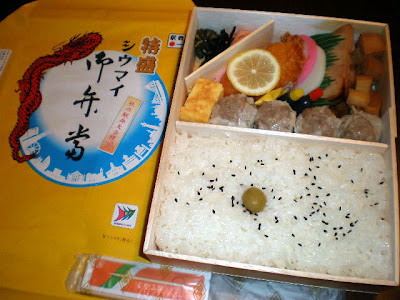
Special size Shumai Bento from Yokohama, since 2008
oomori ekiben 大盛り駅弁 Large-size ekiben
. . . CLICK here for Photos !
*****************************
Worldwide use
*****************************
Things found on the way
日本列島駅弁
source : BS JAPAN 駅弁列島
Ekibengaku kooza 駅弁学講座
Hayashi Junshin / Kobayashi Shinobu
ISBN 4087200523
Ekiben History
http://www.ekibento.jp/study-ekibenhistory.htm
Ekiben Museum
http://eki-ben.web.infoseek.co.jp/index.html
*****************************
HAIKU
駅弁に掌のひら程の鮭がつき
ekiben ni te no hira no shake ga tsuki
station lunch box ...
a piece of salmon
the size of my hand
Hoshi Reiko 星令子
:::::::::::::::::::::::::::::::::::::::::::::::::::::::::::::::::::::::::::::::::::::::::::::::::::::
ekiben -
my thoughts follow
the rails
a little drama
at every station -
ekiben
Gabi Greve, June 2009
*****************************
Related words
***** WASHOKU : General Information
***** WASHOKU : Regional Japanese Dishes
***** WASHOKU
Roadside stations (michi no eki 道の駅) Highway Service Areas
BACK TO TOP
***** WASHOKU : EKIBEN 駅弁 Station Lunch Boxes
:::::::::::::::::::::::::::::::::::::::::::::::::::::::::::::::::::::::::::::::::::::::::::::::::::
